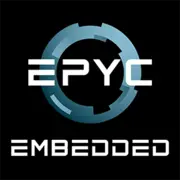AMD EPYC Embedded 3251

The AMD EPYC Embedded 3251 processor is a powerful and efficient CPU designed for server applications. With a total of 8 cores and 16 threads, this processor offers impressive multi-threading capabilities, making it well-suited for handling demanding workloads in server environments. The base frequency of 2.5 GHz and max turbo frequency of 3.1 GHz ensure high performance, while the 16MB L3 cache helps to reduce latency and improve overall responsiveness.
One of the most notable features of the EPYC Embedded 3251 is its low thermal design power (TDP) of 55W. This means that it can deliver high levels of performance while remaining energy efficient, leading to lower operating costs for server deployments.
Benchmark tests, such as Geekbench 6, also showcase the impressive performance of this processor, with a single-core score of 870 and a multi-core score of 4939. These scores demonstrate the ability of the EPYC Embedded 3251 to handle both single-threaded and multi-threaded tasks with ease.
Overall, the AMD EPYC Embedded 3251 processor is a compelling choice for server applications, offering a balance of high performance, energy efficiency, and multi-threading capabilities.
Basic
Label Name
AMD
Platform
Server
Launch Date
February 2018
Model Name
?
The Intel processor number is just one of several factors - along with processor brand, system configurations, and system-level benchmarks - to be considered when choosing the right processor for your computing needs.
EPYC Embedded 3251
Code Name
Zen
Foundry
GlobalFoundries
Generation
EPYC Embedded (Zen (Snowy Owl))
CPU Specifications
Total Cores
?
Cores is a hardware term that describes the number of independent central processing units in a single computing component (die or chip).
8
Total Threads
?
Where applicable, Intel® Hyper-Threading Technology is only available on Performance-cores.
16
Performance-core Base Frequency
2.5 GHz
Performance-core Max Turbo Frequency
?
Maximum P-core turbo frequency derived from Intel® Turbo Boost Technology.
3.1 GHz
L1 Cache
96K per core
L2 Cache
512K per core
L3 Cache
16MB shared
CPU Socket
?
The socket is the component that provides the mechanical and electrical connections between the processor and motherboard.
AMD BGA SP4r2
Bus Frequency
100MHz
Multiplier
25.0
Unlocked Multiplier
No
Technology
?
Lithography refers to the semiconductor technology used to manufacture an integrated circuit, and is reported in nanometer (nm), indicative of the size of features built on the semiconductor.
14 nm
TDP
55 W
PCIe Version
?
PCI Express is a high-speed serial computer expansion bus standard used for connecting high-speed components, replacing older standards such as AGP, PCI, and PCI-X. It has gone through multiple revisions and improvements since its initial release. PCIe 1.0 was first introduced in 2002, and in order to meet the growing demand for higher bandwidth, subsequent versions have been released over time.
3
Transistor Count
4.8 billions
Memory Specifications
Memory Type
?
Intel® processors come in four different types: Single Channel, Dual Channel, Triple Channel, and Flex Mode. Maximum supported memory speed may be lower when populating multiple DIMMs per channel on products that support multiple memory channels.
DDR4-2666
Memory Channels
?
The number of memory channels refers to the bandwidth operation for real world application.
2
ECC Memory Support
Yes
GPU Specifications
Integrated Graphics Model
?
An integrated GPU refers to the graphics core that is integrated into the CPU processor. Leveraging the processor's powerful computational capabilities and intelligent power efficiency management, it delivers outstanding graphics performance and a smooth application experience at a lower power consumption.
N/A
Miscellaneous
PCIe Lanes
32
Share in social media
Or Link To Us
<a href="https://cputronic.com/en/cpu/amd-epyc-embedded-3251" target="_blank">AMD EPYC Embedded 3251</a>